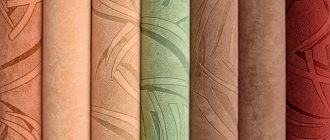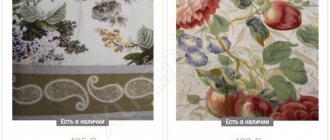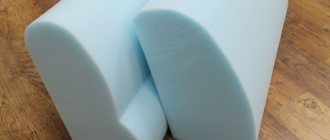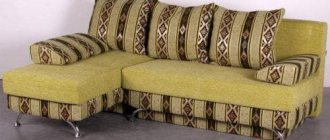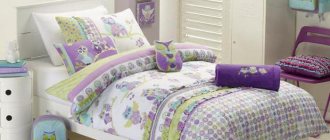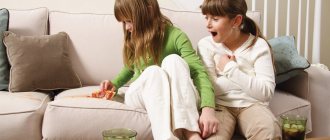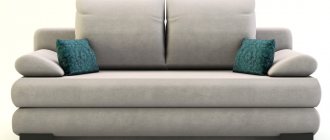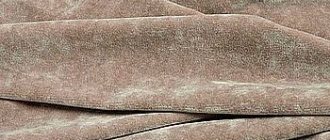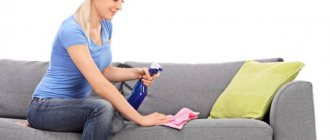Home/Design and interior/Choosing sofa upholstery: flock or velor
To create an interior, the material chosen for the upholstery of the sofa is of no small importance. From its quality, structure, color, even the most simple sofa in structure can acquire a luxurious and impressive look. There are many varieties of upholstery fabrics, some of them are flock and velor, which have a number of significant advantages over others.
Velours
Velor upholstery fabric has long been recognized as the most spectacular and beautiful fabric that gives the interior coziness, luxury and originality. It is pleasant to the touch and has sufficient strength.
Its undeniable advantages include:
- Natural cotton and wool threads that make up the base of the fabric allow it to retain heat;
- The color range is so diverse that it is possible to match the color to any interior;
- The strength of velor allows it to be easily washed, vacuumed, and stains removed using special means, while it retains its original appearance.
But at the same time, some features of the fabric should be taken into account:
- Velor, as a natural and fleecy fabric, requires delicate handling and does not tolerate stains from coffee, sauces or wine, therefore it is not desirable for kitchen sofas;
- As a fabric made from natural fibers, it also has a corresponding cost, which is slightly higher than average;
- Over time, the fabric is wiped off, since it does not contain synthetic components.
Deciding on the upholstery of the sofa: super instructions on types of material
1
The durability, comfort and appearance of the sofa depend on the quality of the upholstery used in its production. Factories offer upholstered furniture covered with various fabrics and non-woven materials, so it will be difficult for an inexperienced buyer to make the right choice. In this article we will talk about the main types of upholstery, their features, disadvantages, and advantages. The collected information will help you choose the right fabric for upholstering your sofa and enjoy your purchase for a long time.
Anna
HomeMe Supervisor. Upholstered furniture expert.
Criteria for choosing upholstery for sofas
If you don’t know where to start and how to choose the right upholstery, we recommend considering the following circumstances:
- what room is the furniture for?
- whether there are cats, dogs or other pets living in the house;
- whether there are or are planned small children in the family;
- Will there be smoking indoors?
The answers to these questions will help you choose a material for a sofa that will serve you for a long time and be affordable.
If you approach the purchase of a sofa more professionally, then you need to pay attention to the following qualities of its upholstery:
- resistance to abrasion, fading, pilling - the more cycles, the better;
- degree of fabric shrinkage and cleaning behavior;
- fire resistance;
- density – optimally from 200g/m2;
- environmental Safety;
- air tightness - the higher it is, the less likely it is for the fabric to crack at the seams.
It is almost impossible to determine these criteria by eye, so the seller needs to ask him for documents indicating the established indicators for a particular fabric.
Types of facing materials for upholstered furniture
All materials used for upholstery of sofas are divided into two groups:
- textile – matting, flock, chenille, velor, velor, jacquard, artificial suede
- non-woven – natural and artificial leather.
To decide which upholstery to choose for your new sofa, you need to study all the features of each material and understand what suits you best.
Gozhka
Dense mixed fabric with a characteristic textured surface. The cost of a sofa with such upholstery depends entirely on the class of material and its composition. The more synthetic threads were used in the production of the fabric, the higher the wear resistance class it has. The advantages of matting are:
- strength;
- abrasion resistance even under intense loads;
- a wide variety of colors;
- affordable price;
- ease of care.
The disadvantages of such upholstery include:
- tendency to fade, so it is better to place the sofa away from direct sunlight;
- is afraid of high temperatures, so drying after wet cleaning should be done only naturally;
- The convex texture of the fabric attracts pets, who pull the threads out of it with their teeth and claws.
Chenille
The material is created by interweaving threads and pile of artificial and natural origin. Among the advantages they note:
- pleasant soft surface reminiscent of corduroy;
- hypoallergenic;
- strength and wear resistance;
- resistance to fading, absorption of odors, deformation;
- practicality and the ability to wash difficult stains at home.
The disadvantages include the high cost of sofa models in chenille, as well as the ability of this fabric to absorb moisture. Cat owners need to be prepared for the fact that animal claw marks on such upholstery are very noticeable.
Velours
This textile contains cotton, viscose, and polyester. This mixture of natural and synthetic threads gives the upholstery the following positive qualities:
- visual appeal;
- tactilely pleasant surface;
- breathability;
- good resistance to deformation.
Velor upholstery is attractive for its appearance, but if you are looking for the most practical and durable furniture, you should consider more durable fabrics. The fact is that this material is very difficult to care for; stains are difficult to remove from it and the pile wears out quite quickly. That is why for families with small children, velor sofas are not the best option.
Flock
A special feature of flock is a wide variety of decorative effects. It can imitate suede, woven materials - chenille, velor. The price of upholstered furniture in this design also depends on the appearance and production technology. Flock sofas are presented in both the budget and premium segments.
To create flock, a base of cotton and polyester is used and nylon pile is glued onto it. The result is a material with the following advantages:
- strength;
- moisture resistance;
- ease of care - stains can be easily removed with soap and water;
- antistatic;
- anti-vandal properties;
- wide selection of colors and patterns;
- pleasant to the touch surface.
It is almost impossible to leave scratches or ripples on the flock, which is why such sofas are recommended for people with pets. Furniture in this finish can be used in any residential area. You should avoid a sofa with flock upholstery if it is planned to be installed in the kitchen or in a room where there is a lot of smoking. This material easily absorbs odors. Also, the disadvantages include a predisposition to abrasion, so for transformable and frequently used sofas you should look for another cladding option.
Jacquard
It contains equal parts of synthetic and natural threads. It feels and looks like artificial silk. The advantages include:
- large selection of colors and prints;
- high strength and wear resistance;
- durability;
- absolute resistance to burnout.
The disadvantages include unsuitability as a vandal-proof coating and difficulty in maintenance. The fabric easily becomes stranded and does not tolerate wet cleaning. In addition, not many people like the smoothness of jacquard.
Tapestry
The material consists largely of cotton, to which a small percentage of synthetic threads may be added. The wear resistance of the upholstery depends on the ratio of the components: the more natural raw materials it contains, the worse it can withstand loads.
The advantages of the tapestry are:
- a wide variety of colors and prints that are distinguished by a rich and luxurious design;
- environmentally friendly and hypoallergenic;
- resistance to moisture.
The main disadvantage is the low degree of wear resistance and susceptibility to rapid abrasion. Pulls from animal claws on such fabric are also easily removed.
Faux suede
In many respects, the material is no different from its natural counterpart: it also has a pleasant-to-touch surface and a wide variety of colors and shades. But the quality characteristics of such upholstery are a level higher, since they are different:
- high strength;
- wear resistance;
- abrasion resistance;
- at an affordable price.
The main thing when buying a sofa made of artificial suede is the choice of quality material. Otherwise, the upholstery will quickly deform and lose its presentation. Such upholstered furniture requires quite careful care, which excludes the use of aggressive detergents and compositions based on petroleum products.
Genuine Leather
Leather is often used for lining sofa frames, as the material has many advantages:
- long service life with careful use;
- environmental Safety;
- moisture resistance;
- easy care.
Flock
Due to its velvet-like appearance, pleasant tactile feel and many other excellent qualities, flock has gained wide popularity as a sofa upholstery material.
Flock refers to non-woven materials. It is based on cotton and polyester, and the fibers are obtained using electrostatic spraying. The artificial base gives the fabric special strength, which allows the upholstery to be used even on an open country veranda.
Among the advantages of flock are:
- Special strength that can withstand the claws of cats and dogs;
- The fabric does not cause allergies, which is important, for example, for children;
- Its moisture resistance allows the use of wet cleaning with chemicals, while the fabric retains its original appearance;
- Wide color palette of fabric, and the colors are extremely resistant to fading;
- The wide range offered, which is possible thanks to the substance from which the flock is made, allows you to choose the fabric to suit any interior;
- The moderate price is attractive to the consumer.
Flock also has disadvantages. It is able to absorb surrounding odors. In this regard, it is advisable to frequently ventilate the room. Like all fleecy fabrics, flock is susceptible to abrasion. Over time, the sofa's upholstery will require replacement.
The right upholstery: how to choose fabric for a sofa
Kinds
Selection for a specific room
Antipet technologies
What to look for in the store
How to calculate footage
Understanding upholstery materials on your own is not easy. This includes the type of fabric and its properties: density, wear resistance, and so on—there are really a lot of parameters. Moreover, the choice is complicated by the purpose of the furniture: different models are needed for a personal office and for a living room. Let's figure out which fabric is best for a sofa and what to consider when purchasing?
What to choose for upholstering a sofa?
Velor and flock are visually very similar. But due to the fact that velor is based on natural fibers, it absorbs moisture well. Flock contains artificial fibers and this determines its moisture resistance, as well as a longer service life.
When choosing upholstery for a sofa, it is very important to take into account not only financial possibilities, but also the place where the sofa will stand.
If the sofa will be used as a sleeping place, then it is better to prefer flock, as the material is more resistant to abrasion. Flock is also suitable for a nursery; it will not cause allergies in the child one hundred percent. It is better for pet owners to turn their attention to flock as a material that is resistant to the claws of your pets. And finally, for the sofa in the kitchen we choose flock.
If you are planning a luxurious interior in the living room, if your task is to create enveloping comfort, beauty or pomp, then the upholstery of your sofa will be velor.
AlinaAuthor of the article
Did you like the article?
Share with your friends:
Using matting for upholstery of sofas: comparison of fabric with velor
Recently, matting fabric has become increasingly used for upholstery of various furniture. A large selection of types, color palette, and the desire for environmentally friendly materials have made this fabric popular among craftsmen. In addition, such upholstery is practical, wear-resistant, and holds its shape well.
Story
The matting material traces its history back to the cattail plant, from which peasants wove various things needed on the farm. But then he was rude.
In a more modern form, the fabric found a second wind thanks to Coco Chanel, the famous fashion designer. This fabric came to be called “Chanel”.
Types of fabrics
For your information! Coco Chanel, fascinated by everything Russian, came up with the idea of using burlap and matting in clothes, giving a vector for the development of fabric manufacturing technology.
One type of Chanel fabric
Composition and properties of the material
Matting is characterized by weaving threads in a checkerboard pattern. Threads are most often natural - linen, wool, cotton, silk, viscose. Synthetic additives include acrylic and polyester. Synthetic additives and yarn twisting have resulted in a fabric that is highly abrasion resistant. It serves for a long time, does not change its shape and appearance.
One of the leading properties of matting fabric is that it does not wrinkle or lose its shape, which is why it is actively used in the furniture industry for upholstery.
Matching upholstery colors
This is an environmentally friendly material, does not cause allergies, is breathable and pleasant to the touch. In addition, it does not absorb odors, so it is actively used not only for furniture upholstery, but also for curtains and drapes, for blankets and bedspreads, for pillowcases, tablecloths, napkins and towels.
Matting is also actively used in clothing because of its ability to hold its shape.
The material is distinguished by density. There are lower ones - for clothing, home textiles, and there are denser types - for curtains, furniture, bags and backpacks.
Furniture matting: pros and cons
The advantages of matting fabric for furniture (sofas, armchairs) are obvious: it lasts a long time, does not wrinkle, does not wear out, does not change shape, is environmentally friendly and hypoallergenic. In addition, in the production of furniture it is also valued for the fact that it allows air to pass through, so it is not hot to sit on sofas upholstered with this fabric in the heat.
You might be interested in this Detailed description of the characteristics of furniture velor Upholstery, matting
Matting is a universal material that goes well with other types, including pile ones. Looks stylish in combination with leather, leatherette, wood, and metal.
Note! The downside may be that animals love it. Matting fabric for a sofa is good for everyone, except for the habit of some animals to sharpen their claws on furniture. However, modern manufacturers have partly solved this problem by adding a special adhesive pad to the fabric.
Color example
Another disadvantage is that the material crumbles easily. If you use it for sewing, you need to leave a large seam allowance so that the edges of the parts can be processed.
Velor or matting for a sofa: which is better?
In addition to matting, other dense fabrics are used for furniture upholstery, such as velor, jacquard, tapestry, chenille, and flock.
Chenille
Chenille is a beautiful and expensive material. Retains color and shape well, does not absorb odors. Soft and durable material, but unstable in front of animal claws. Due to its high cost, it is not particularly in demand.
Chenille
Flock
Flock is the most popular of the upholstery materials, which has a velvety structure. It has proven itself well in care and is used for furniture in the nursery, living room, and bedroom. The disadvantage is the absorption of odors, which means that it is better not to use furniture with flock upholstery in the kitchen or cafe.
Flock
What styles does matting go with?
Matting is a universal material. Combines with wood, leather, and metal. Therefore, it can be used in different interior styles, with the exception of palace and magnificent ones.
In modern interiors, matting looks good in high-tech, Provence, Russian, Norwegian, loft, maritime, classic, English, as well as fantasy or eclectic styles.
Care instructions
It is recommended to use the following tips for care:
Material care
- Curtains and matting upholstery can be cleaned with a vacuum cleaner or a soft clothes brush.
- If the fabric is dirty, spray it with a spray bottle and clean it with a sponge and soapy water.
- If the stain is difficult to remove, then it is better to use folk remedies for removing grease or glue stains.
- The matting is sensitive to chlorine, as the fabric changes color. The same applies to aggressive detergents.
- To wash removable matting textiles, choose a delicate wash.
- A steam generator is very effective for cleaning sofas made of this material.
How to change old upholstery yourself
You can change the upholstery on furniture yourself if you have experience in reupholstering furniture.
Removing the upholstery
First, you should carefully measure all the parameters of the furniture and add about half a meter of fabric just in case of fire. You should either attach new upholstery to a well-cleaned old one, or remove the old one and re-upholster the furniture.
To reupholster, you need a furniture gun and appropriate staples, as well as glue, preferably universal, such as “Moment Crystal” or “Titanium,” scissors, a needle and thread, or a sewing machine.
Prices for upholstery fabrics for furniture
The cost depends on the density, composition, design of the fabric itself. In general, prices vary from 250 rubles. for 1 m² and above.
You might be interested in How to sew tulle on eyelet rings yourself
According to customer reviews, matting is practical in everyday use, it is easy to clean, and furniture made from this material looks good and pleases the eyes of its owners for a long time.
Source: https://tkanix.guru/tkani-v-interere/tkan-rogozka-dla-divana
